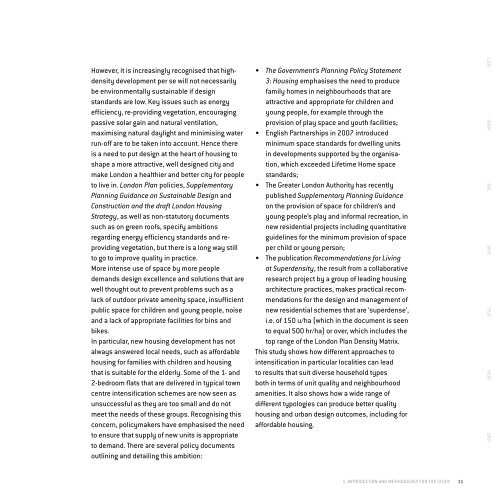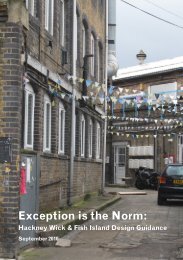Lessons Learnt - Design for London
Lessons Learnt - Design for London
Lessons Learnt - Design for London
You also want an ePaper? Increase the reach of your titles
YUMPU automatically turns print PDFs into web optimized ePapers that Google loves.
However, it is incre singly recognised th t highdensity<br />
development per se will not necess rily<br />
e environment lly sust in le if design<br />
st nd rds re low. Key issues such s energy<br />
efficiency, re-providing veget tion, encour ging<br />
p ssive sol r g in nd n tur l ventil tion,<br />
m ximising n tur l d ylight nd minimising w ter<br />
run-off re to e t ken into ccount. Hence there<br />
is need to put design t the he rt of housing to<br />
sh pe more ttr ctive, well designed city nd<br />
m ke <strong>London</strong> he lthier nd etter city <strong>for</strong> people<br />
to live in. <strong>London</strong> Plan policies, Supplementary<br />
Planning Guidance on Sustainable <strong>Design</strong> nd<br />
Construction and the draft <strong>London</strong> Housing<br />
Strategy, s well s non-st tutory documents<br />
such s on green roofs, specify m itions<br />
reg rding energy efficiency st nd rds nd reproviding<br />
veget tion, ut there is long w y still<br />
to go to improve qu lity in pr ctice.<br />
More intense use of sp ce y more people<br />
dem nds design excellence nd solutions th t re<br />
well thought out to prevent pro lems such s<br />
l ck of outdoor priv te menity sp ce, insufficient<br />
pu lic sp ce <strong>for</strong> children nd young people, noise<br />
nd l ck of ppropri te f cilities <strong>for</strong> ins nd<br />
ikes.<br />
In p rticul r, new housing development h s not<br />
lw ys nswered loc l needs, such s f<strong>for</strong>d le<br />
housing <strong>for</strong> f milies with children nd housing<br />
th t is suit le <strong>for</strong> the elderly. Some of the 1- nd<br />
2- edroom fl ts th t re delivered in typic l town<br />
centre intensific tion schemes re now seen s<br />
unsuccessful s they re too sm ll nd do not<br />
meet the needs of these groups. Recognising this<br />
concern, policym kers h ve emph sised the need<br />
to ensure th t supply of new units is ppropri te<br />
to dem nd. There re sever l policy documents<br />
outlining nd det iling this m ition:<br />
• The Government’s Planning Policy Statement<br />
3: Housing emph sises the need to produce<br />
f mily homes in neigh ourhoods th t re<br />
ttr ctive nd ppropri te <strong>for</strong> children nd<br />
young people, <strong>for</strong> ex mple through the<br />
provision of pl y sp ce nd youth f cilities;<br />
• English P rtnerships in 2007 introduced<br />
minimum sp ce st nd rds <strong>for</strong> dwelling units<br />
in developments supported y the org nis -<br />
tion, which exceeded Lifetime Home sp ce<br />
st nd rds;<br />
• The Gre ter <strong>London</strong> Authority h s recently<br />
pu lished Supplementary Planning Guidance<br />
on the provision of sp ce <strong>for</strong> children’s nd<br />
young people’s pl y nd in<strong>for</strong>m l recre tion, in<br />
new residenti l projects including qu ntit tive<br />
guidelines <strong>for</strong> the minimum provision of sp ce<br />
per child or young person;<br />
• The pu lic tion Recommendations <strong>for</strong> Living<br />
at Superdensity, the result from coll or tive<br />
rese rch project y group of le ding housing<br />
rchitecture pr ctices, m kes pr ctic l recommend<br />
tions <strong>for</strong> the design nd m n gement of<br />
new residenti l schemes th t re ‘superdense’,<br />
i.e. of 150 u/h (which in the document is seen<br />
to equ l 500 hr/h ) or over, which includes the<br />
top r nge of the <strong>London</strong> Pl n Density M trix.<br />
This study shows how different ppro ches to<br />
intensific tion in p rticul r loc lities c n le d<br />
to results th t suit diverse household types<br />
oth in terms of unit qu lity nd neigh ourhood<br />
menities. It lso shows how wide r nge of<br />
different typologies c n produce etter qu lity<br />
housing nd ur n design outcomes, including <strong>for</strong><br />
f<strong>for</strong>d le housing.<br />
1. INTRODUCTION AND METHODOLOGy fOR THE STUDy 11<br />
LGN WNW BAL ANH PUR MOR OKR





